GLOSSARY OF TERMS
- Bandar-log – Unloaded keyword. It has no rules associated with it but other cards may reference or care about cards with this keyword.
- Banish – Place this card out of the game.
- Book – Term for your main draw deck of cards.
- Damage +1 – Loaded keyword which means, “When this character wins a skirmish, the losing character(s) receives +1 additional wounds.”
- Defender +1 – Loaded keyword which means, “The Protagonist may assign 1 additional minion to skirmish this companion.”
- Exert – Place a wound token on a character. You cannot exert a character with 1 health.
- Fetch – Look through a pile of cards for a card indicated. Select one of them, revealing that card to the rest of the table and add it to your hand. If you look through your book in this manner, shuffle it afterwards.
- Field – Term for “in play.”
- Hero [ ] – Loaded keyword which means, “This companion can be your party’s hero, bearing the Quest-need listed in the brackets.”
- Quest-bound – Unloaded keyword. It has no rules associated with it and other cards do not reference it in the demo game.
- Sanctuary 3 – Loaded keyword which means, “When the campaign phase begins, if the party is at this site, remove up to 3 total wounds from the party.”
- Scrap – Move this card from the field to its owner’s scrap pile.
- Spot – Have the card (or cards) with the specified features on the field and active.
- Thumbless – Loaded keyword. It is not utilized in the demo game.
Set Up
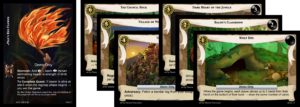
Set aside the 7 cards which are double-sided.
The six horizontal cards are site cards. They will be set aside in a side deck called your “atlas.” You may stack them in any order, there is no need to shuffle them
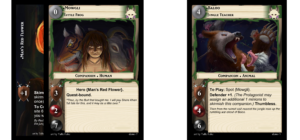
Find the “Mowgli” and “Baloo” companion cards and put them into play. Attach “Man’s Red Flower” – your Quest Need – to Mowgli like so.
Your Quest Need is what your hero will require to complete their quest. On it will be the instructions for what you need to do complete Mowgli’s quest and win the game.
Shuffle your remaining cards together to form a deck you will draw from called your “book.” Draw the top 8 cards to form your starting hand.
Determine randomly who will go first. (Coin flip, rock-paper-scissors, dice rolls, etc) The first player will select site 1 “Wolf Den” from their atlas and place it in the middle of the table.
Each player then places a marker to represent them on that site.
The Dichotomy
The most important concept to the Heroes’ Journey is that each card in your book belongs to one of two sides. In the top left corner, around a number representing a cost, will be either a grey circle for a CAMPAIGN card or a black diamond for an ADVERSARY card.
During your turn you are the PROTAGONIST and play your CAMPAIGN cards to help your hero’s journey. When it is your opponent’s turn, you are the ANTAGONIST and play your ADVERSARY cards to hinder your opponent’s hero.
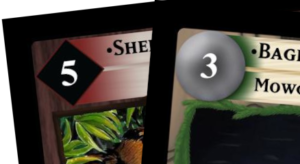
Phases of a Turn
- CAMPAIGN PHASE
- ADVERSARY PHASE
- MELEE PHASE
- Assignment Step
- Skirmish Step(s)
- REGROUP PHASE
CAMPAIGN phase
The first phase of the turn, the current player – the PROTAGONIST – plays their Campaign cards.
ADVERSARY phase
The second phase of the turn, the other player – the ANTAGONIST – plays their Adversary cards.
The Event Exception
Most cards you will play during the campaign phase or adversary phase of the turn. The exception are event cards.
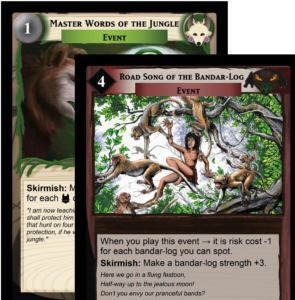
Event cards you save in your hand until the part of the turn listed in their gametext. In the demo game, all events are played during skirmish steps.
The CAMPAIGN Phase
PLAYING CARDS
The first part of the first phase of the turn, is where you play Campaign cards.
When you play a Campaign card, you ADD a number of tokens equal to its cost from the supply to the center of the table in a RISK POOL. You must also fulfill any “To Play:” requirements on a card.

To SPOT something means the card is in play and ACTIVE. During your turn, your Campaign cards are active, your opponent’s Campaign cards are inactive. (Imagine they are turned facedown or otherwise not in play.) To play Bagheera, YOU must have a card titled Mowgli in play – you cannot spot your opponent’s copy of Mowgli. (Card titles are marked in game text via [ ].)
![]()
To EXERT a character means to place a wound token on that character to represent physical effort. A character with 1 health cannot be exerted.
The COMPANION cards Bagheera and Kaa are placed in the same line as Mowgli and Baloo to represent the PARTY that is helping the hero. Note also how they have a • in front of their names. This means they are UNIQUE characters. You cannot play another copy of a unique character that you have in play or in your grave. However, during the campaign phase if you have a unique companion in play who is wounded, you may discard a copy of that character from your hand to give them a SECOND WIND – removing 1 wound token from that character.
The CONDITION card “Hunting for Food” has “Support Area” on its type line. This means that after you have added its risk cost to the risk pool, it is placed onto the field behind the party line where it may be used in the future.
MOVING YOUR PARTY
Once you have played all the cards you wish, you will then MOVE your party’s token to the next site.
If there is no site present on the ADVENTURE PATH, the Antagonist looks through their Atlas, selects the next site by number, and places it in the path. (Example: During the first turn, when the first player decides to move from site 1, the other player will put site 2 onto the adventure path.)
The Protagonist then moves their party token to the next site and adds risk to the pool equal to the risk number in the site’s top right corner + 1 token for each companion in the party.
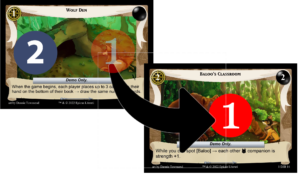
The ADVERSARY Phase
Now the Antagonist player plays MINIONS to attack and hinder the party’s advancement. Minions are character cards belonging to the Adversary side. When you play an Adversary card, you must REMOVE a number of tokens from the risk pool equal to its cost. If there are not enough risk tokens available, you cannot play your card.
Note that minion cards have a number in a symbol identical to the site symbol under their strength and health value.
This is a minion’s home site. If the site you are playing a minion to a site that has a number LOWER than that minion’s home site, you must pay a ROAMING PENALTY cost of +2 additional risk.

(Example: This minion with a home site of 4 would cost +2 risk if played to site 2.)
Once the Antagonist has played all the minions they wish or are able to play, the melee phase begins.
EXAMPLE TABLE

The MELEE Phase
The melee phase is subdivided into two steps.
Assignment Step
First is the ASSIGNMENT STEP. The Protagonist takes the minions in play and assigns them to skirmish a companion. Each companion may only be assigned to skirmish 1 minion at a time except Baloo who has the keyword “Defender +1” meaning the Protagonist may assign 1 or 2 minions to skirmish him.
Once all companions have been assigned (or the Protagonist declines to assign any more), if any minions remain unassigned the Antagonist player takes them and assigns them to skirmish any companions they wish (even if this results in a companion assigned to fight more than one minion).
Skirmish Step(s)
Once assignment is complete, the Protagonist then chooses the order skirmishes resolve. Each companion participates in its own skirmish step.
Compare the companion’s strength value with the minion assigned to them. If more than one minion is participating, add all of their strengths together. The Protagonist has first opportunity to take an ACTION or PASS. You may activate any “Skirmish:” game text on a card in play (such as Man’s Red Flower or Hunting for Food) to increase your companion’s or reduce opposing minions’ strength, or you may also play a Campaign EVENT with “Skirmish:” in its game text. Once the action has been taken, it resolves fully. The effect of the action (example: strength +2) remains only until the end of the step. (Later in the turn, the companion’s strength will not have the +2 bonus.)
After the Protagonist takes an action or passes (does nothing), then the Antagonist has an opportunity to also take an action or pass. Like the Protagonist, they can use any adversary card with “Skirmish:” in its game text or play an Adversary event with “Skirmish:” in its game text.
Once the action has resolved, the opportunity to take another action returns to the Protagonist. Both sides go back and forth in this manner during the skirmish step until BOTH SIDES PASS CONSECUTIVELY. One of the players may choose to pass once and perform an action the next time they are able if their opponent performs an action.
RESULTS OF A SKIRMISH
After both sides have passed, calculate the final total of both sides’ strength.
- If one side’s total is DOUBLE OR MORE than the other’s total, the losing side is OVERWHELMED. All losing characters are killed regardless of how much health they have.
- If one side has a total GREATER than the other without overwhelming, each losing character receives ONE WOUND. If the winning character had the “Damage +1” keyword then 1 additional wound is dealt to the loser. If a character receives wounds equal to or exceeding their health, it is killed.
- If both sides are tied, the minions wins.
Place killed minions in their owner’s scrap pile. Place killed companions in their owner’s GRAVE – a pile of cards separate from the scrap pile. Survivors of the skirmish are set aside and now considered “unassigned.”
Once the skirmish step is concluded and the consequences dealt out, the Protagonist then chooses another assigned companion (if any) and repeats the above procedure until all assigned skirmishes are resolved.
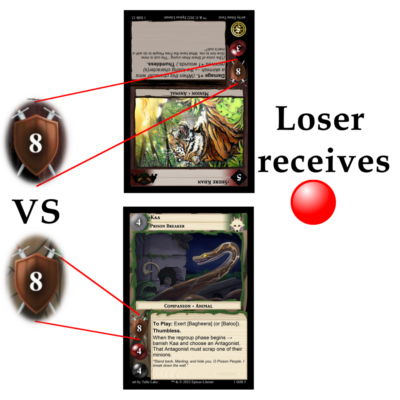
The REGROUP Phase
During the regroup phase, do the following IN ORDER:
Antagonist Reconciles
The Antagonist draws cards from their book until they have 8 cards in their hand.
Protagonist Decides
MOVE – If the party has moved only once this turn, then the Protagonist may choose to move again. If they do, use the same move procedure that you did during the campaign phase. Then the turn goes back to the adversary phase and the Antagonist has a new opportunity to play more minions followed by another melee phase.
STAY – If the Protagonist chooses to stay (or must stay because they have already moved twice this turn), then the Protagonist reconciles, drawing cards from their book until they have 8 cards in hand. Any minions that are still on the field are placed in their owner’s scrap pile.
WINNING THE GAME
If your hero, Mowgli, dies, you lose the game.
However, if you make it to site 6, “Council Rock” and Mowgli survives to the regroup phase, then you have won the game!